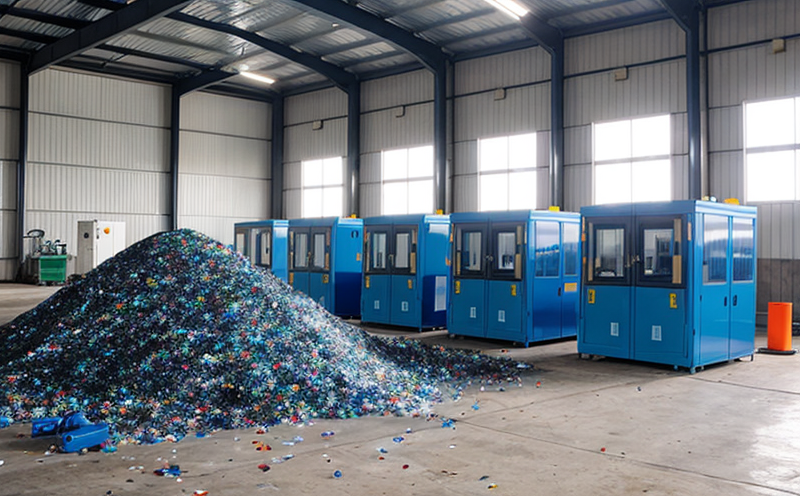EN 15359 Plastics Contamination Level Assessment
The EN 15359 standard provides a robust framework for assessing contamination levels in recycled plastics. This test is critical for ensuring the quality and performance of plastic products, particularly those derived from post-consumer waste streams. The assessment helps identify contaminants that could affect product integrity and compliance with regulatory standards.
Recycling plastics presents unique challenges due to the variability in source materials. Contaminants such as metal, glass, or other non-plastic substances can degrade the performance of recycled products. By quantifying these contaminants, EN 15359 ensures that recycled plastics meet stringent quality requirements set by industry standards and regulatory bodies.
The test involves several key steps: sample preparation, contamination detection using specialized analytical techniques like X-ray fluorescence (XRF) or inductively coupled plasma optical emission spectrometry (ICP-OES), and ultimately, the calculation of contamination levels. The results provide actionable insights for quality management teams to optimize recycling processes.
Understanding the scope of this test is crucial for stakeholders involved in waste management and recycling. It highlights the importance of precise measurement techniques and the need for accurate reporting to ensure trustworthiness in the market. This standard has a direct impact on the reliability of recycled plastics, influencing everything from product design to end-user satisfaction.
The EN 15359 framework is widely recognized across Europe and aligns with broader sustainability goals. It contributes significantly to reducing environmental impact by promoting the use of recycled materials while ensuring that products meet stringent quality benchmarks.
| Sample Type | Tolerance Levels | Testing Methods |
|---|---|---|
| Polyethylene (PE) | <1% by weight | XRF, ICP-OES |
| Polypropylene (PP) | <0.5% by weight | ICP-OES, FTIR |
| Polyethylene Terephthalate (PET) | <2% by weight | XRF, ICP-OES |
The standard is essential for industries relying heavily on recycled plastics. It ensures that materials used in manufacturing meet stringent quality standards, thereby enhancing product performance and durability.
For manufacturers, this test offers a means to verify the purity of their recycled feedstocks. By identifying contamination early in the process, they can make informed decisions about which batches to use, thus minimizing waste and optimizing production efficiency. This not only improves bottom lines but also supports sustainability initiatives by reducing reliance on virgin materials.
The EN 15359 standard is particularly valuable for businesses looking to comply with regulatory requirements or gain a competitive edge in the market. It provides a clear pathway to ensure that recycled plastics meet industry standards, thereby fostering trust among consumers and stakeholders alike.
Industry Applications
The EN 15359 standard finds extensive application across various sectors where plastic recycling is crucial:
- Plastic Manufacturing: Ensures consistent quality in recycled plastics used for manufacturing consumer goods.
- Retail and Packaging: Supports the use of recycled materials in packaging solutions, enhancing sustainability credentials.
- Construction Industry: Facilitates the use of recycled plastics in construction products like pipes and roofing membranes.
- Automotive Sector: Enables the incorporation of recycled plastics into automotive components for both environmental and cost-saving benefits.
The test is also beneficial for waste management companies that aim to optimize their recycling processes, reduce contamination levels, and enhance product quality. By leveraging EN 15359, these entities can ensure they meet regulatory standards while contributing positively to the circular economy.
Why Choose This Test
- Precision in Measurement: The standard employs advanced analytical techniques that offer precise and reliable contamination assessments.
- Regulatory Compliance: Ensures adherence to international standards, providing peace of mind for compliance officers.
- Data-Driven Decision Making: Offers detailed insights into contaminant levels, aiding in informed decision-making processes.
- Sustainability Focus: Supports the use of recycled materials while maintaining product quality and performance.
The EN 15359 test is a cornerstone for ensuring that recycled plastics meet stringent quality benchmarks. Its reliability and precision make it an indispensable tool in waste management and recycling processes.
Competitive Advantage and Market Impact
- Enhanced Product Quality: By assessing contamination levels, this test helps manufacturers produce high-quality recycled plastics that meet or exceed industry standards.
- Increased Brand Trust: Demonstrating a commitment to quality through precise contamination assessments can significantly enhance brand reputation and customer trust.
- Market Differentiation: Companies using EN 15359 can differentiate themselves by offering products made from high-quality recycled materials, appealing to eco-conscious consumers.
- Growth Opportunities: Compliance with this standard opens doors for businesses looking to expand their market reach and tap into growing sustainability trends.
The widespread adoption of EN 15359 in the plastic recycling industry highlights its role as a pivotal tool for driving innovation, enhancing product performance, and fostering sustainable practices. Its impact is felt not only within the recycling sector but also across industries that depend on recycled plastics.





